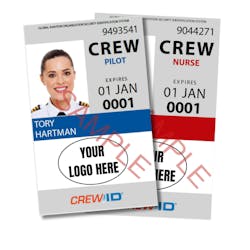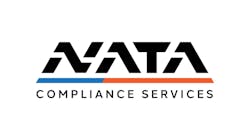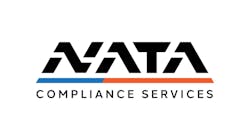Many workplaces require employee identification. Depending on the type of work being performed and security factors at a specific location, ID badge requirements may vary.
At an airport, for example, Tyler Bartoo, client success specialist at NATA Compliance Services (NATA CS), explained during NATA CS’s Crew Badging, Best Practices and Benefits webinar, security is priority. Those responsible for airport badging must make sure the components of their IDs reflect the security needs.
Basic IDs vs. Secure Badges
A basic identification card can be found in many places – even in retail settings. A basic badge, Bartoo says, will include the employer or company’s name, the employee’s name, a full-faced image of the employee, an employee ID number and perhaps an expiration date.
“That's kind of your most basic stuff,” Bartoo says.
To go beyond a basic badge, security features can be incorporated. They include instant verification, real-time updating, biometric data, counterfeit deterrence and identifiable positions, Bartoo notes.
“A secure badge is going to have some sort of instant verification – some way for that to be checked by security at different locations, in real time,” he says. “Real-time updating goes along with that. It can have the employee’s status with the company that can be updated, again in real time, and then be verified.”
Biometric data offers more security than a simple photo of the badge holder. Descriptions that include hair color, eye color, height and other physical attributes help security personnel properly identify the badge holder.
Counterfeit deterrence makes reproduction of the badge more difficult. As a result, security personnel can quickly identify fake identification badges.
Since different types of employees have various responsibilities and access requirements, including identifiable positions on ID badges is key.
For instance, Bartoo says where a ground service provider or customer support person may need access to may differ from where a pilot or mechanic may need to go.
Bartoo adds employee badges should also be compliant with recommendations set forth by the International Civil Aviation Organization (ICAO).
NATA CS officials note it is important to remember that badges are based on data and specifics of the individual person being identified. It’s critical that a security badge ties to verifiable data of that person, which can include the currency of required training for specific access or use and other data that an identification system manages, NATA CS officials explain.
Airport Badges vs. Crew Badges
Depending on the airport, a variety of identification badges issued by various sources may be found. Nonetheless, guaranteeing the security of an airport is critical.
When it comes to badges produced by airports, the most common airport badge is a SIDA badge.
A SIDA (or security identification display area) badge is typically issued to people, such as ground handling personnel, who work beyond the screening checkpoint in sterile areas. They typically include personnel who work on and around aircraft, among others.
“Not all airports do SIDA badging,” Bartoo notes. “But if you are at a SIDA airport, that’s probably not something you're going to get around. You're going to have to have that. That's going to be the rules of that particular airport.”
Whether an airport is using SIDA badges or something else, airport-issued identification is designed to meet the needs of that specific airport and TSA requirements.
“An airport may not be a SIDA airport, but they may have some other kind of program in place that you'll have to comply with to be at their location,” Bartoo says.
“However, these airport badges, they may not qualify as crew badges.”
Crew badges serve a slightly different purpose, Bartoo notes. They may not work outside of the specific airport they're designed to work for. What’s more, requirements and rules are going to vary from one airport to another airport.
The Known Crewmember (KCM) program allows for crew badges, but Bartoo notes there is limited availability to that program.
“You must be operating under the employer’s 135 or 125 certificate. You must be actively operating under the employer’s either Twelve-Five Standard Security Program or Private Charter Standard Security Program,” he explains. “So one of those two TSA security programs, as well as the personnel must be an FAA-certified flight crew.
“Those are the basic components there you need in order to qualify for that.”
Badges may be restricted by airport, but that is not a limitation of a badge’s technology, but rather current policies and insufficient alignment in training and standards across airports, NATA CS officials note. In areas or individual use cases where this can be addressed, NATA CS officials say secure badges can be applied to operate in multiple locations based on one identity management system.
For example, NATA CS has its own badge and credentialing system, called CrewID.
Aviation companies in good business standing that complete a vetting process are eligible for CrewID, Bartoo explains.
“You do have to be a company – an individual can't sign up to get badging with CrewID. We have to be able to vet the company,” he says, noting companies associated with advanced air mobility, vertiport and UAS/UAV would be eligible for CrewID badges.
Part 91, corporate flight departments may want to participate in the KCM program, designed for charter operations, but do not qualify. However, corporate flight departments can issue employees secure badges through CrewID.
While Part 135 and Part 125 operators are potentially eligible for KCM, Bartoo says there are KCM-eligible companies that use both KCM and CrewID.
“How you choose to do that at your operation is up to you. But it goes beyond just those FAA-certified flight crew members,” Bartoo says, noting FBOs and repair stations, contract pilots and air medical personnel may also benefit from CrewID.
Alternatively, a company may print its own badges in-house or utilize a third-party to have ID badges produced. When using a third-party provider, Bartoo says there are key considerations that should be factored into that decision.
“What level of security do the badges offer?” Bartoo says. “Whatever badging system you're looking at, make sure they’re checking all those boxes for you.
“If you're doing a vendor or service provider of some kind, there's probably other companies that are using them,” he continues. “So, what kind of vetting is going into that? Is anybody looking into these companies?”
Bartoo also suggests reviewing the positions available on a badge.
“The identifiable positions help someone from a security standpoint,” he says, noting identifiable position should align with industry standards. “What kind of positions do they have to choose from? Are they kind of just like making them up or are they more consistent?”
Properly Displaying Badges
Identification badges are a critical component to airport security. But as Bartoo notes, a secure badge doesn’t serve its purpose if it isn’t displayed properly.
“This is probably pretty intuitive,” he says.
If a badge is hanging off a belt hoop, inside a shirt pocket or under a jacket, he adds, that's not necessarily helping much.
An airport badge should be displayed in a clearly visible location.
Bartoo says a neck lanyard or a clip on the exterior of a shirt pocket are really good options.
“In a past life many years ago, I worked in baggage at the local airport,” he adds. “I had an armband because a neck lanyard was potentially a little bit dangerous for the equipment that I worked with.”
While an armband is a safe, secure option, it must still be displayed correctly – on the upper bicep/below the shoulder – where it can be easily seen.
To help ensure proper ID display, Bartoo suggests creating a policy that clearly states expectations for personnel to comply with best practices.
Airport Badging Policies
Updated security measures were being implemented slowly before the COVID pandemic added urgency to these policies, according to Bartoo.
With increased security checks, new challenges may arise.
“If you don't have identification, requirements for an escort have become quite common,” Bartoo says. “I've worked with a few maintenance companies where they had mechanics that traveled and they went to a particular location. And at that location – because they didn't have a badge or company identification – they were required to have an escort with them.”
An FBO or airport may charge for the escort’s time and they may even have a minimum amount of time that they charge for, which Bartoo notes could factor into business practices. So, he says it’s important to understand the reasons for having a secure airport identification badge.
In addition to wearing a badge in a clearly visible location, there are important best practices for badges and related procedures and policies.
Bartoo emphasizes badges should not be shared by multiple people.
“Everyone should have their own badge with their own photo unique to that person. The content on that badge, the information, should be clear and legible – obviously not smudged or damaged in a way where you can't read it, or tell who it is.”
The photo should be current, too.
According to Bartoo, it is also important to establish an easy-to-understand method by which badges are issued and managed.
“Do you have a checklist or something that you're following, or some kind of process that you're following, every time to issue or manage the badges that you can put out to your employees?” he says. “If someone leaves the company or the badge expires, whatever the case may be, do you have a process to retrieve those badges and destroy them? And how do you know? How can you verify and make sure that that's happening?”
Having processes in place allows a business to ensure these details are tracked correctly, Bartoo adds.
“Do you have the ability to deactivate and reactivate badges? You may work with some contract employees too. It’s pretty common in our space,” he continues. “So, you may want to issue a badge to a contract employee. Maybe you don't want that badge to be active all the time. Can you activate it while they're working for you and deactivate it while they're not? Having that ability, at the very least, is important.
“Can you verify the employee status with the company? Are they an active employee? Are they not an active employee? Can that be checked by someone in security?”
Within a badging policy, Bartoo recommends including language for lost, stolen or damaged badges.
“Legibility is really important with these things, so if the badge becomes damaged or you can't read the name, what's the policy by which that employee can get a new badge issued, or can get a replacement issued?” he says.
“Or if they lose it,” Bartoo continues. “Can they get that replaced in some way and are you able to track that process?”
If a badge is not working or it is showing the incorrect status for an employee, a policy should make it clear where issues can be reported and corrected.
When printing ID badges in-house rather than relying on third-party provider, Bartoo says, “authorized personnel should be the ones that have access to either ordering or printing badges. You don't necessarily want anyone to just be able to walk into a room and print out a badge.”
When printing in-house, he recommends securing all materials. This provides a safeguard even if someone with nefarious goals gains access to the printer.
Because mechanical issues and breakdowns can occur. Bartoo also recommends having a back-up printer in a secure location to avoid disruptions in operations.









